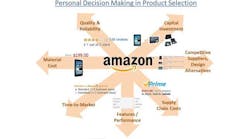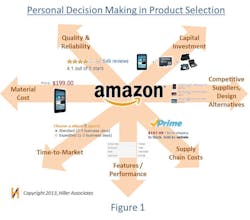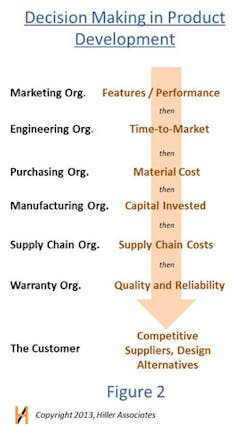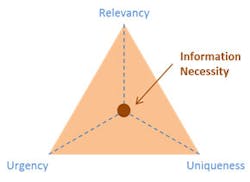We just finished the biggest shopping season of the year from Thanksgiving to Christmas. A lot of people were making a lot of decisions about where to spend their hard-earned money -- mostly for the benefit of others with gifts.
During that same period, design engineers around the world were rushing to finish up pressing projects -- and, probably as fast as possible, because they had a lot of vacation left to use, before the end of the year.
We make decisions every day in our personal and professional lives. But, do we make decisions the same way in both worlds? I don’t believe so. People might argue that decisions made at work involve much more complexity. After all, how much product development is really going on in most homes? However, a lot of product selection is going on in people’s personal lives. When considering complex product purchases, product selection starts to resemble product development in many ways. Let’s take a look at how people (including design engineers) make decisions when shopping (product selection) vs. how they make decisions in the corporate world (product development).
Consider the ubiquitous Amazon.com. Customers’ product selection experience on Amazon is overwhelmingly positive: Amazon scores 89 out of 100 in customer satisfaction, the top online retailer score in 2012. But product selection is ‘easy’ right? Wrong. Look at Figure 1. Product Selectors on Amazon must consider multiple product attributes and, moreover, these attributes mirror the considerations of a product developer very closely. Product Selectors must consider performance, cost, delivery time, quality, capital investment, etc., without any salesman or other expert to guide them. But the really amazing thing is that the Product Selectors using Amazon are able to both prioritize these product attributes and consider them simultaneously.
So, how do the same people who are Amazon customers typically consider product attributes in the corporate world? Very differently is the short answer, as we see in Figure 2. First of all, people at work do not tend to trade-off product attributes simultaneously, but in series. Moreover, often each functional group in a product company (marketing, engineering, manufacturing, etc.) tends to be concerned with one dominating attribute, almost to the exclusion of other product attributes. How does the typical series-based consideration of product attributes that is common in the corporate world compare to the simultaneous trade-off approach that the customers of Amazon use? Exact numbers are difficult to find, but some sources say only 60% of products are successful. While not a precise comparison, the difference seems meaningful: Amazon scores 89 of 100 on the customer satisfaction index, whereas product companies have 60% successful products.
There are at least three reasons why the product selection and product development processes differ, and the corporation can learn from all three.
Clear attribute prioritization
Which product attribute is more important: time-to-market, product cost, or performance? There’s no right or wrong answer, in general, but there is a right answer for any given situation. The question is: Does the product developer KNOW the priorities of different attributes. As an individual shopper, you may not explicitly write down the prioritization, but you know it. Your preferences and value system are welded into your DNA, so it is clear. However, companies are not individuals, but collectives of them. It is the responsibility of the product line executive to make these priorities clear to everyone.
This is similar to requirements engineering, but at a strategic level. Requirements are typically specific and only apply to a narrow aspect of the product. I am talking about the high-level product attribute priority. Ask your product line executive: “In general, as we go through our development, what should typically ‘win’ in a trade-off decision.”
If the executive cannot give you a concise and simple answer, he has some work to do to earn his big salary. For example, he should be able to say something, such as “We must meet all minimum requirements of the product, but we need to get to market as fast as possible, so we meet or beat our delivery date. Oh, and we need to keep an eye on product cost.”
The product executive needs to write the priorities down and share them with all. In this case, he might write:
- First Priority: Time-to-market
- Constraint: minimum performance requirements met
- Second Priority: Product Cost
This doesn’t mean the product executive will not change the priority later as the conditions change, but for now, the whole organization is clear on the priorities. This sounds very simple, but most people in product development are unsure of what the clear priorities are. Therefore, they make up their own.
Simultaneous attribute trade-off and value optimization
The second thing that we learn from Amazon shopping is to consider all the constraints and targets for product attributes simultaneously. As we see looking at Figure 1 versus Figure 2, people naturally do this on Amazon, but organizations typically let a different priority dominate by functional silo. There are often arbitrage points (optimums in the design space) that will allow excellent results in one attribute, by only sacrificing minimally on another attribute. For example, the product executive may have said time-to-market is first priority, but he is likely to be happy to sacrifice one unit of time-to-market for an increase of 10 units of performance. This doesn’t mean that the organization is changing their priorities, but that the strategic priorities discussed above simply function as a guiding light that the product development team pivots around to find the point of maximum value for the customer.
Filter for relevant information, not just more or new information
Recent research is revealing the dangerous downsides of our always-on, always-new, always-more information society. To be sure, social media, like all technologies has the potential for adding a lot value. The question is: Do you control the information or does it control you. The research featured in Newsweek shows three problems that have grown in importance over the last decades:
- “Recency” Overpowering Relevance – The human brain tends to vastly overweight new information in decisions vs. older information, and our modern digital world throws tons of new information at us.
- Immediacy vs. Accuracy – the flip side of the first problem is that real-time nature of our online world pushes people to make quick decisions. Accuracy and thoughtfulness are seen as inefficient delays, especially in today’s corporate environment.
-
Information Overload – More information does not lead to better decisions according to research. Humans quickly reach a point where people make bad decisions because they have too much information. They cannot process it all and do not properly filter it. The brain literally shuts off certain processing centers, which causes bad decisions.
What can your product development team do to promote better decisions?
To answer this, let’s first ask how Amazon is able to overcome these challenge. To overcome the Recency vs. Relevancy challenge, Amazon ensures that recency is not the default option for the display of Amazon customer reviews. Instead, helpfulness of the review (relevance), as judged by other customers, is the default order. Amazon does not push immediacy. There are no annoying pop-ups offering a deal, if you buy in 10 minutes. Certainly, Amazon does make buying easy and fast, but shopping at Amazon from the comfort of one’s home is a relaxing experience that promotes thoughtfulness. Finally, Amazon does not overload the customer with information. This is no small task, given that Amazon may offer literally hundreds of items to the customer among which he must decide. Amazon does this by presenting the information on a huge variety of products in a standard way, and by providing simple and powerful filters that discard large amounts of extraneous information.
In order to overcome these new information challenges in your own product development work, ask yourself these three questions:
2. Urgency – Do we need to make this decision today? How long do we have to consider the problem before the decision must be made?
3. Uniqueness – Is this new piece of information truly unique or just a variation of something I know already? If it is a repeat, file it mentally and/or physically with the original information, and forget about it. It is it truly unique, consider whether the new information would be a primary influencer of you design or not. Most of the time information is just that: information, not relevant unique knowledge. In this case, once again, file and forget.
The world of online journals, social media, corporate social networks, and interconnected supply-chain applications is here to stay. It brings a world of new opportunity for better and more up to date information for product development. It also brings a deluge of extraneous information, and we need to accept this and learn to manage this. Amazon.com manages these challenges well. Your product development team can manage these challenges too using the principles outline above.
Eric Arno Hiller is an authority in product cost management (PCM). Hiller was the co-founder and founding CEO of two high technology start-ups: aPriori (a PCM software platform) and End Around. Previously, he worked in product development and manufacturing at Ford Motor Co., John Deere and Procter & Gamble. He is currently the president of Hiller Associates and the author of the PCM blog www.ProductProfitAndRisk.com. Mr. Hiller holds an MBA from the Harvard Business School and a master’s and bachelor’s degree in mechanical engineering from the University of Illinois Urbana-Champaign.







